National premiere | Animal brain organoid culture strategy

process
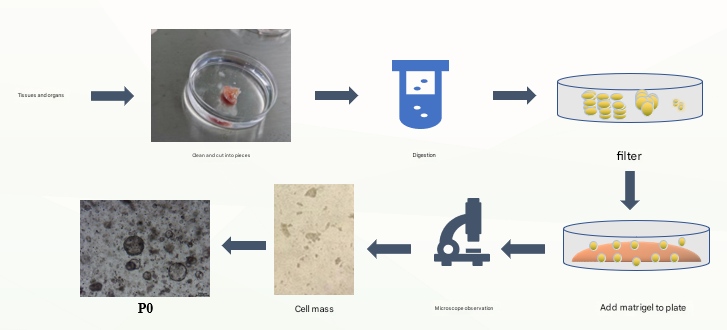
Primary culture workflow for organoids
Primary
1. Preparations
1. Instruments and equipment
CO2Incubator, double single-sided clean table, inverted microscope, tabletop refrigerated centrifuge, water bath (ABS72023) or water bath shaker, medical refrigerator, -80°C freezer, pipette (one set), ophthalmic scissors, ophthalmic tweezers
2. Reagent consumables (taking bowel cancer as an example)
Animal Brain Organoid Medium Kit (abs90050), Matrigel (low factor, phenol red-free) (abs9495), 60 mm cell culture dish (abs7005), 100 μm filter sieve (abs7009), 15 mL centrifuge tubes (abs7102), 1.5 mL EP tubes ( ABS7119), 24-well cell culture plates (ABS7035), metal ice boxes, ophthalmic scissors, ophthalmic forceps

|
Component name |
specification |
|
Animal Brain Organoid Medium A |
100mL |
|
Organoid primary culture buffer B |
250mL |
|
Primary tissue digest C |
30mL |
|
Organoid passaging digest D |
30mL |
|
Tissue preservation solution E |
100mL |
|
Organoid cryopreservation solution F |
20mL |
|
Organoid subculture buffer G |
250mL |
Second, the operation process
1. Sample preparation
(1) Place the tissue in a sampling vial containing pre-chilled (2-8 °C) tissue preservation solution E (submerge the entire tissue) and retrieve it from the hospital/laboratory at 4 °C;
(2) Sterilize the sampling bottle, take out the tissue and put it into the Petri dish to take a photo, and register, size, color, softness and hardness, tissue type and other information.

2. Cleaning - shredding
(1) Soak in a 60 mm cell culture dish (abs7005) with 2-3 mL of primary culture buffer B. Wash three times with primary culture buffer B (change the dish each time) and then chop and cut into approximately 1-3 mm3Tissue blocks, transfer to a 15 mL centrifuge tube.
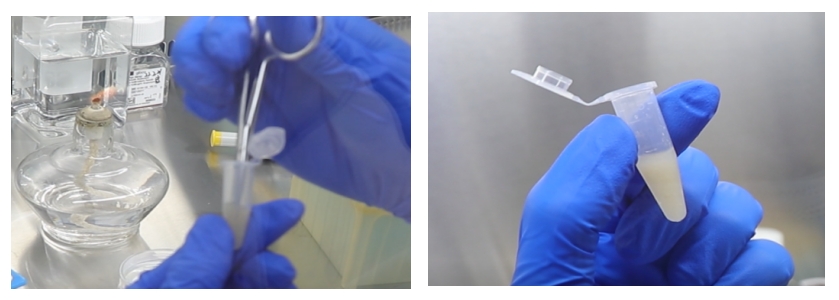
3. Digestion and filtration
(1) Add 5 times the primary tissue digest C to a 15 mL centrifuge tube (digestion volume: tissue volume = 5:1, if it is difficult to estimate the tissue volume, 5 ml of digestion solution is usually sufficient) at 37 °C for digestion 15-30min (observe the digestion at any time during the digestion process).
(2) Take a small amount of liquid and observe it under the microscope, and after observing more cell clusters (5-50 cell clusters) under the microscope, add 3 times the volume of primary culture buffer B (buffer volume: digestion volume = 3:1) to terminate digestion. Gently pipette with the tip of the pipette to see the liquid become cloudy.
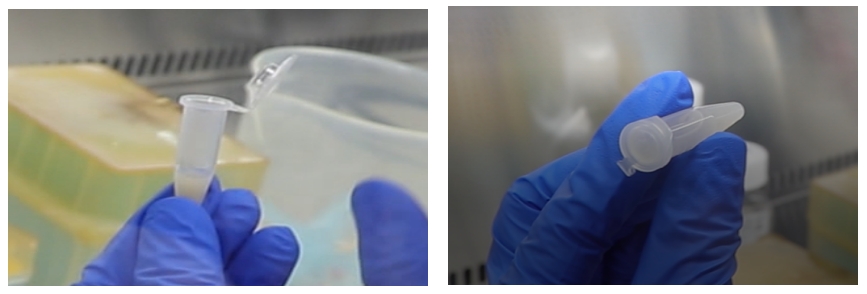
(3) Use a 100μm filter sieve (ABS7009) for filtration, and take a small amount of filtrate for observation under the microscope. The filtrate was collected into a 15 mL centrifuge tube, enriched at 300 g at 4 °C for 5 min, and the supernatant was removed.

4. Add glue - dot plate - add liquid (here is the finishing touch of the entire primary operation).
(1) Preparation
A Matrigel needs to be stored in a metal ice box and melted overnight in a refrigerator at 4°C;
b Pipette heads and centrifuge tubes need to be pre-cooled at -20°C for at least half an hour in advance;
c The melted Matrigel can be stored at 4°C all the time, and it is recommended to use it up within 2 weeks.
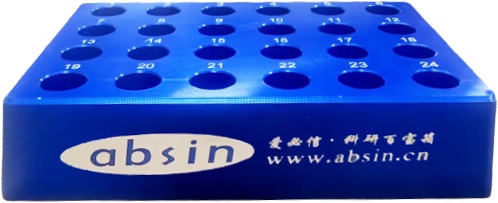
(2) Vaccination requirements
24-well plate (abs7035), 25 uL of Matrigel cell mass mix per well, 500-750 uL of organoid culture medium.
(3) Inoculation density
Density recommendation 1: Matrigel volume: cell pellet volume = 25:1 (if it is difficult to estimate the cell pellet pellet volume, usually 300uL Matrigel is sufficient).
Density recommendation 2: 500 cell clusters/25 uL Matrigel (if you want to count the seeding, you can refer to this density recommendation).
(4) Glue - dot plate
Matrigel (ABS9495) was added to the cell pellet, and the mixture was carried out by pipetting (do not blow full, it is easy to produce bubbles), and then the plate was spotted. The entire operation is carried out on a metal ice box or ice. After the operation is proficient, the glue is added, mixed evenly, and the dot plate is controlled within half a minute, which is conducive to maintaining the good fluency of the matrix glue.
(5) Add liquid
The lined plates were placed in a 37°C incubator for 40-60 min to form gelatin, and 500-750μL of organoid medium A was added for culture. In about 10-14 days, most organoids are 200 u m-500 um in diameter and can be passaged.
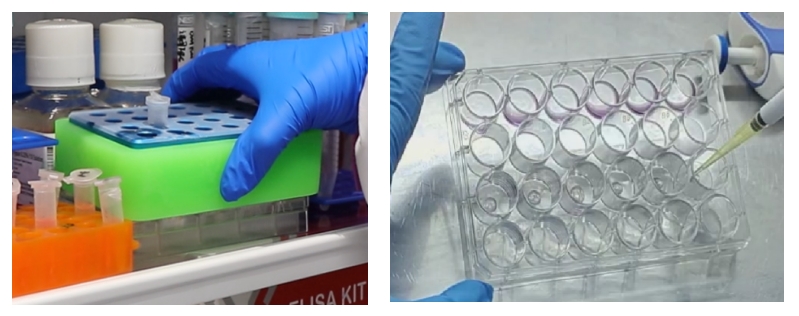
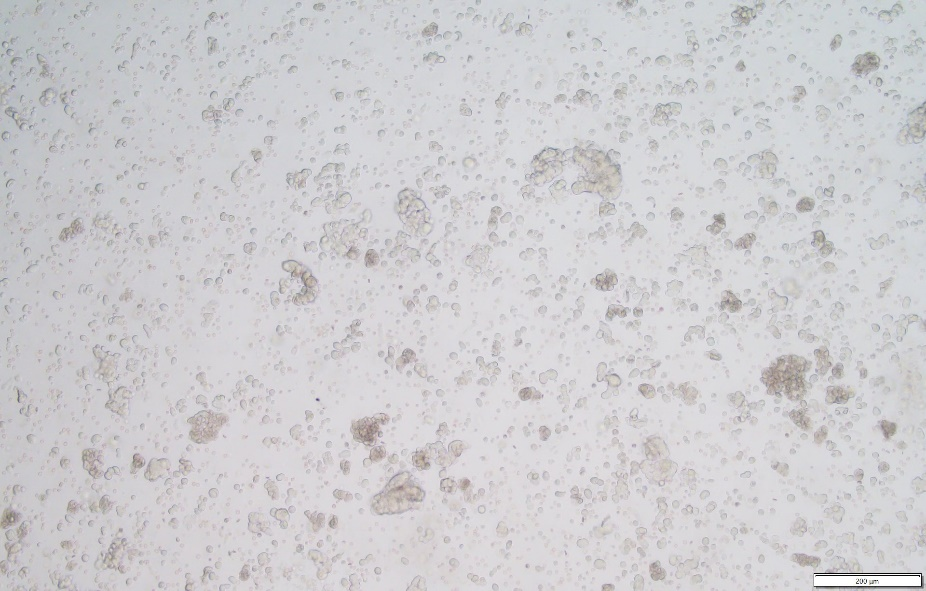
Plating density
Passage (digestion in two cases).
1. Passage steps for a large number or volume of organoids
1. Organoid collection and washing
(1) Collection: The pipette aspirates the medium, adds 1-2mL of about 4 °C organoid subculture buffer G per well, gently blows off the Matrigel, and collects it in a 15mL centrifuge tube (24-well plates, each 5 wells as a group).
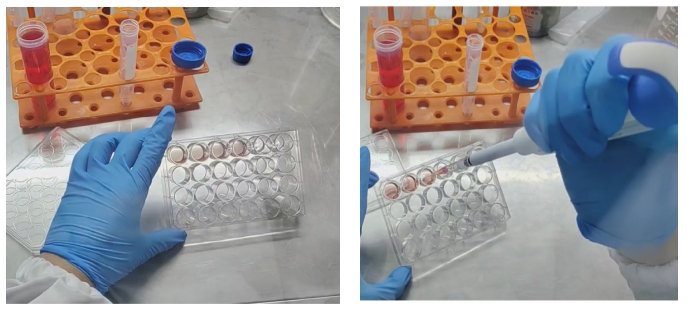
(2) Washing: add organoid subculture buffer G to 14mL (the more buffers, the more fully diluted Matrigel, the easier it is to remove), stand at 4 °C for 40min or -20 °C for 5min (the purpose is to soften Matrigel, if the refrigerator has a strong thermal insulation effect, shorten the freezing time, and explore the appropriate freezing time, The centrifuge tube can be removed, and the Matrigel cannot be seen by shaking, indicating that the cooling is good).
(3) Next, the centrifuge tube is centrifuged at 300g, 4 °C, and centrifuged for 5min.
The first is the normal situation, which is divided into three layers (as shown below), at which point the supernatant and matrigel layer are discarded and the organoid pellet can be retained.
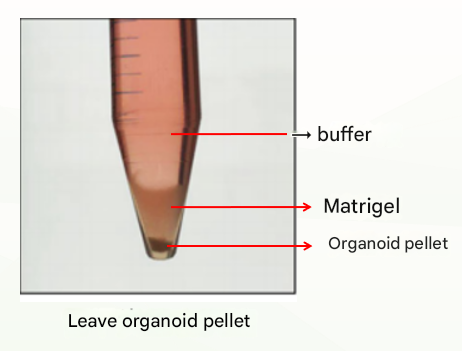
The second is an abnormal situation, which is divided into two layers (as shown below), which may be related to insufficient cooling. At this time, discard the buffer, leave the matrix colloid organoid suspension, repeat the previous washing step, cold centrifugation again, and usually clear stratification (buffer layer, matrigal layer, organoid precipitation layer), at this time, discard the supernatant and matrigel layer, and retain the organoid pellet. If there are still two layers (buffer layer and Matrigel organoid suspension layer), discard the buffer and the top 1/3 of Matrigel organoid suspension and keep the bottom 2/3.
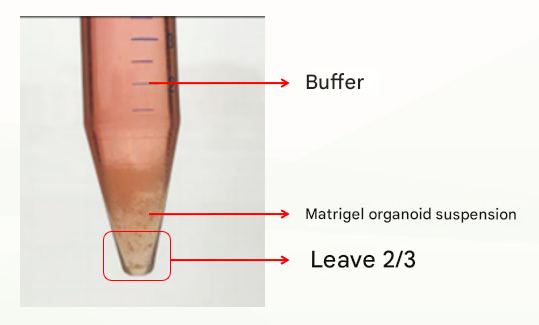
Conditions to facilitate efficient isolation of Matrigel and organoids:
a The choice of centrifuge is very important, and the horizontal angle centrifuge is more conducive to the separation of Matrigel and organoids than the fixed angle centrifuge;
b The temperature of the centrifuge should be 4 °C (to avoid the curing of Matrigel), the centrifugal speed can be appropriately increased (the maximum should not exceed 500g), and the centrifugation time can be appropriately extended (the most common is not more than 10min).
2. Organoid digestion
(1) Add 2-3mL of organoid passage digestion solution D to digest in the ultra-clean table for 2-3min, and pipette 1-2 times during digestion. This step is mainly to digest the cell clumps, never digest into single cells, and the survival rate of single-cell organoids is low. If you are unsure whether digestion is appropriate, you can aspirate a few microliters and observe it under a microscope, and if there are more cell clumps, you can stop digestion.
(2) Add 5 times organoid subculture buffer G (buffer: digestion solution = 5:1) to terminate digestion, centrifuge at 300g at 4 °C for 5min to discard the supernatant (if there is Matrigel residue, the residual amount < 50uL is normal, and does not affect the proliferation of submerged organoids).

3. Glue addition - spot plate - liquid addition
(1) Preparation
A Matrigel needs to be stored in a metal ice box and melted overnight in a refrigerator at 4°C;
b Pipette heads and centrifuge tubes need to be pre-cooled at -20°C for at least half an hour in advance;
c The melted Matrigel can be stored at 4°C all the time, and it is recommended to use it up within 2 weeks.
(2) Vaccination requirements
24-well plate (abs7035), 25 μL Matrigel cell mass mix per well, 500-750μL organoid culture medium.
(3) Inoculation density
Density recommendation 1: Organoids are usually passaged 1:2, e.g., 5 wells are collected in a 24-well plate and 10 wells are passaged, and the amount of Matrigel required is 25*10= 250uL
Density recommendation 2: 500 cell clusters/25 uL Matrigel (if you want to count the seeding, you can refer to this density recommendation).
Note: Regardless of Density Recommendation 1 or Density Recommendation 2, if there is any residual Matrigel, the amount of new adhesive should be at least 1.5 times the amount of residual adhesive.
(4) Glue - dot plate
Matrigel (ABS9495) was added to the cell pellet, and the mixture was carried out by pipetting (do not blow full, it is easy to produce bubbles), and then the plate was spotted. The entire operation is carried out on a metal ice box or ice. After the operation is proficient, the glue is added, mixed evenly, and the dot plate is controlled within half a minute, which is conducive to maintaining the good fluency of the matrix glue.
(5) Add liquid
Put the laid culture plate into a 37 °C incubator for 40-60 min to form gelatin, and add 500-750 μL of human colorectal cancer organoid medium A for culture. In about 10-14 days, most organoids are 200-300um in diameter and can be passaged.
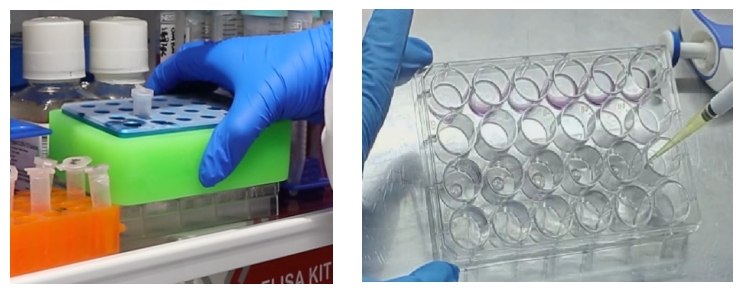
2. When the number of organoids is insufficient or the volume is small:
1. Organoid collection, blowing and washing
(1) Aspirate the medium with a pipette, add 1-2mL of 4°C organoid subculture buffer G to each well, and gently blow off the Matrigel;
(2) Pipette and blow the organoids into cell clumps (the blowing can be stopped when there are more cell clumps observed under the sampling microscope);
(3) Washing: 24-well plates, every 5 wells as a group, collected in a 15mL centrifuge tube, add organoid subculture buffer G to 14mL (the more buffer, the more fully the Matrigel is diluted, the easier it is to remove), stand at 4 °C for 40min or -20 °C for 5min (the purpose is to soften the Matrigel, if the refrigerator has a strong thermal insulation effect, shorten the freezing time, and explore the appropriate freezing time, The centrifuge tube can be taken out and shaken, and the Matrigel cannot be seen, indicating that the cooling is good);
(4) Next, the centrifuge tube is centrifuge at 300g, 4 °C, and centrifugation for 5min.
The first is the normal situation, which is divided into three layers (as shown below), at which point the supernatant and Matrigel layer are discarded and the cell pellet can be retained.
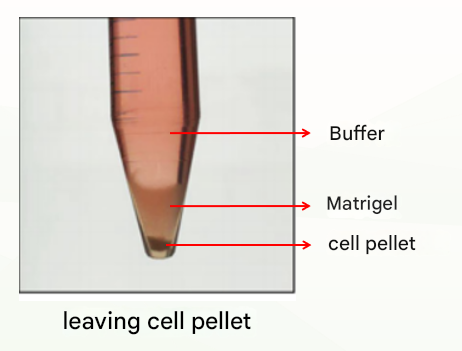
The second is an abnormal situation, which is divided into two layers (as shown in the figure below), which may be related to insufficient cooling. At this time, discard the buffer, leave the Matrigel organoid suspension, repeat the previous washing step, cold centrifugation again, and there is usually clear stratification (buffer layer, Matrigel layer, organoid precipitation layer), at this time, discard the supernatant and Matrigel layer, and retain the organoid pellet. If there are still two layers (buffer layer and Matriglia cell suspension layer), discard the buffer and the top 1/3 of the Matriglia cell suspension and keep the bottom 2/3.
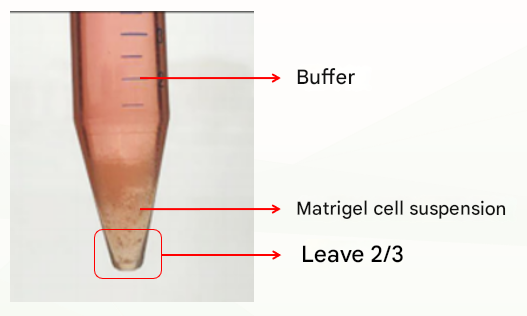
Conditions to facilitate efficient isolation of Matrigel and organoids:
a The choice of centrifuge is very important, and the horizontal angle centrifuge is more conducive to the separation of Matrigel and organoids than the fixed angle centrifuge;
b The temperature of the centrifuge should be 4 °C (to avoid the curing of Matrigel), the centrifugal speed can be appropriately increased (the maximum should not exceed 500g), and the centrifugation time can be appropriately extended (the most common is not more than 10min).
2. Add glue-dot plate-add liquid
(1) Preparation
A Matrigel needs to be stored in a metal ice box and melted overnight in a refrigerator at 4°C;
b Pipette heads and centrifuge tubes need to be pre-cooled at -20°C for at least half an hour in advance;
c The melted Matrigel can be stored at 4°C all the time, and it is recommended to use it up within 2 weeks.
(2) Vaccination requirements
24-well plate (abs7035), 25 μL Matrigel cell mass mix per well, 500-750μL organoid culture medium.
(3) Inoculation density
Density recommendation 1: For cases with a low number of organoids, 2-3 wells are required to enrich into 1 well in order to maintain the paracrine signal required for growth, e.g., 24-well plate collection6holes, 2 wells are enriched with 1 well, and 3 holes are laid, and the amount of matrix gel required is 25*3=75uL.
Density recommendation 2: 500 cell clusters/25 uL Matrigel (if you want to count the seeding, you can refer to this density recommendation).
Note: Regardless of whether it is recommended by density 1 or 2 by density, if there is any residual matrice, the amount of new adhesive is at least 1.5 times the amount of residual gel
(4) Glue - dot plate
Matrigel (ABS9495) was added to the cell pellet, and the mixture was carried out by pipetting (do not blow full, it is easy to produce bubbles), and then the plate was spotted. The entire operation is carried out on a metal ice box or ice. After the operation is proficient, the glue is added, mixed evenly, and the dot plate is controlled within half a minute, which is conducive to maintaining the good fluency of the matrix glue.
(5) Add liquid
The lined plates were placed in a 37°C incubator for 40-60 min to form gelatin, and 500-750μL of organoid medium A was added for culture. In about 7-10 days, most organoids are 200-300um in diameter and can be passaged again.
Cryopreservation
Essentials of cryopreservation:
Organoids do not need to be digested (the recovery rate of digested organoids is low);
Cryopreserved during the exponential growth period of organoids (when the organoid activity is worse than that in the exponential period), that is, after the passage of Day3-Day4, most of the organoids have a diameter of 100um- 200um, this time is the choice of cryopreservation.
1. Organoid collection and washing
1. Collection: The pipette aspirates the medium, adds 1-2mL of 4°C organoid subculture buffer G per well, gently blows off the matrix gel, and collects it in a 15mL centrifuge tube (24-well plate, every 5 wells as a group).

2. Washing: add organoid subculture buffer G to 14mL (the more buffers, the more fully the Matrigel is diluted, the easier it is to remove), and stand at 4 °C for 40min or -20 °C for 5min (the purpose is to soften the Matrigel, if the refrigerator has a strong thermal insulation effect, shorten the freezing time, and grope for the appropriate freezing time, you can take out the centrifuge tube and shake it to see the Matrigel, which means that the cooling is good.) )。
3. Next, the centrifuge tube is centrifuge at 300g, 4°C, and centrifugation for 5min.
The first is the normal situation, which is divided into three layers (as shown below), at which point the supernatant and matrigel layer are discarded and the organoid pellet can be retained.

The second is an abnormal situation, which is divided into two layers (as shown below), which may be related to insufficient cooling. At this time, discard the buffer, leave the matrix colloid organoid suspension, repeat the previous washing step, cold centrifugation again, and usually clear stratification (buffer layer, matrigal layer, organoid precipitation layer), at this time, discard the supernatant and matrigel layer, and retain the organoid pellet. If there are still two layers (buffer layer and Matrigel organoid suspension layer), discard the buffer and the top 1/3 of Matrigel organoid suspension and keep the bottom 2/3.

Conditions to facilitate efficient isolation of Matrigel and organoids:
a The choice of centrifuge is very important, and the horizontal angle centrifuge is more conducive to the separation of Matrigel and organoids than the fixed angle centrifuge;
b The temperature of the centrifuge should be 4 °C (to avoid the curing of Matrigel), the centrifugal speed can be appropriately increased (the maximum should not exceed 500g), and the centrifugation time can be appropriately extended (the most common is not more than 10min).
2. Cryopreservation of organoids
1. Cryopreservation density, taking 24-well plates as an example
Density recommendation is 1:2 wells/mL cryopreservation solution
Density recommendation 2: 500 organoids/mL cryopreservation solution (if you want to count cryopreservation, you can refer to this density recommendation).
2. Add an appropriate amount of organoid cryopreservation solution F, gently blow and resuspend, and it is recommended to cryostore immediately. (If left for too long, DMSO will damage the organoids).
3. Gradient cryopreservation: put the cryopreservation tube into the gradient cryopreservation box and then store it at -80 °C overnight, and take it out and put it in the liquid nitrogen tank the next day.
Manual cryopreservation: 4 °C freezer for 30min, transfer to -20 °C for 1h, then move to -80 °C overnight, take out the next day and put it in the liquid nitrogen tank.
recovery
1. Preparation before the experiment
1. Preheat the water bath to 37°C;
2. Routine disinfection of the cell laboratory, spraying with preventive spray and irradiating ultraviolet light for 40min on the ultra-clean workbench;
3. Place the sterilized centrifuge tubes, straws, culture plates, etc. in order in the ultra-clean workbench.
2. Take out the cryopreservation tube
1. Find the number of the required organoids according to the label according to the cryopreservation record of organoids;
2. Take out the cryopreservation box from the liquid nitrogen tank, take out the required cryopreservation tube, and check the number outside the cryopreservation tube at the same time.
3. Thaw quickly
1. Quickly put the cryopreservation tube into the preheated water bath to thaw, and shake it continuously to make the liquid in the tube melt quickly;
2. After about 1-2min, the liquid in the cryopreservation tube is completely dissolved, take it out and wipe the outer wall of the cryopreservation tube with an alcohol cotton ball, and then take it into the ultra-clean table.
4. Transfer the organoid cryopreservation solution into a 15mL centrifuge tube, add 10 times the volume of organoid subculture buffer G (buffer volume: cryopreservation volume = 10:1) to resuspend, gently pipette and mix well, Centrifuge at 300g at 4 °C for 5 min, discard the supernatant.
5. Add glue - spot plate - add liquid
1. Preparation
(1) Matrigel needs to be stored in a metal ice box and melted overnight in a refrigerator at 4°C;
(2) Pipette heads and centrifuge tubes need to be pre-cooled at -20°C for at least half an hour in advance;
(3) The melted matrigel can be stored at 4°C all the time, and it is recommended to use it up within 2 weeks.
2. Recovery requirements
24-well plate (abs7035), 25 μL Matrigel organoid mix per well, 500-750 μL organoid culture.
3. Resuscitation density
The resuscitation density is recommended to be inoculated at a ratio of 1:1:1 (it turns out that a few wells will be resuscitated if there are a few frozen wells);
Recommended recovery density 2: 250 organoids/25uL Matrigel (if you want to count the seeding, you can refer to this density recommendation).
4. Add glue to the dot plate
Matrigel (ABS9495) was added to the organoid pellet, and the mixture was carried out by pipetting (do not blow full, it is easy to produce bubbles), and then the plate was spotted. The entire operation is carried out on a metal ice box or ice. After the operation is proficient, the glue is added, mixed evenly, and the dot plate is controlled within half a minute, which is conducive to maintaining the good fluency of the matrix glue.
5. Add liquid
The lined plates were placed in a 37°C incubator for 40-60 min to form gelatin, and 500-750μL of organoid medium A was added for culture. In about 10-14 days, most organoids are 200 u m-500 um in diameter and can be passaged.
6. Identification diagram of brain organoids
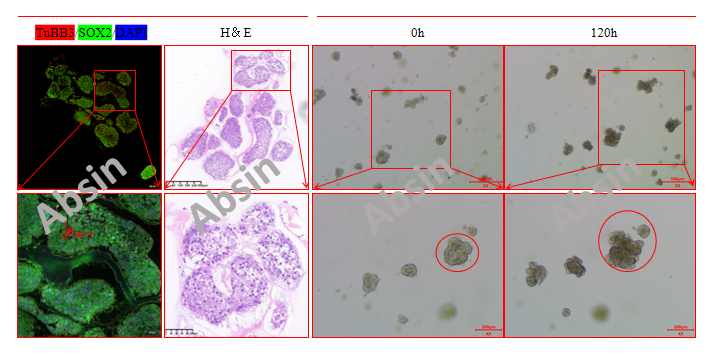
That's all for today's explanation, if you have experimental questions, welcome to join the group to communicate!
This issue is recommended by Xiaoai
|
Catalog number |
name of article |
specification |
|
Organotial Human Gastric Cancer Organoid Medium Kit |
1kit |
|
|
Matrigel (low factor, no phenol red) |
1.5ml*8 |
|
|
abs7289 |
2mL cryogenic metal ice box (24-well, flat bottom) |
1 pc |
|
abs7005 |
60 mm cell culture dish |
1 box |
|
abs7233 |
100 μm filter sieve |
1 box |
|
abs7164 |
Cell cryovials |
1 box |
|
abs7035 |
Cell culture plates (standard clear 24-well plates) |
1 box |
|
Several 1.5mL EP tubes |
1 box |
|
|
abs7102 |
15 mL centrifuge tubes |
1 box |
|
abs7100 |
50 mL centrifuge tubes (culet-bottom) |
1 box |
|
abs7053 |
10 mL disposable pipettes |
1 box |
|
abs7054 |
25 mL disposable pipette |
1 box |
Absin provides antibodies, proteins, ELISA kits, cell culture, detection kits, and other research reagents. If you have any product needs, please contact us.
|
Absin Bioscience Inc. Email: worldwide@absin.net |
 Follow us on Facebook: Absin Bio Follow us on Facebook: Absin Bio |




